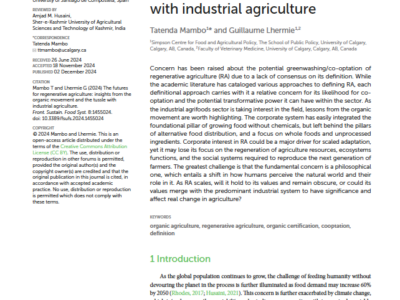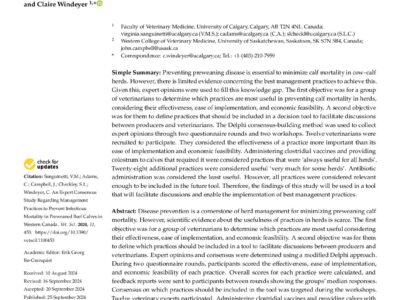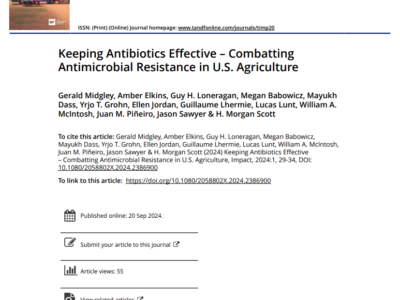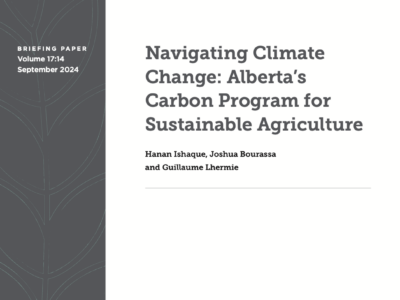Publications
Concern has been raised about the potential greenwashing/co-optation of regenerative agriculture (RA) due to a lack of consensus on its definition. While the academic literature has cataloged various approaches to defining RA, each definitional approach carries with it a relative concern for its likelihood for co-optation and the potential transformative power it can have within the sector. As the industrial agrifoods sector is taking interest in the field, lessons from the organic movement are worth highlighting. The corporate system has easily integrated the foundational pillar of growing food without chemicals, but left behind the pillars of alternative food distribution, and a focus on whole foods and unprocessed ingredients. Corporate interest in RA could be a major driver for scaled adaptation, yet it may lose its focus on the regeneration of agriculture resources, ecosystems functions, and the social systems required to reproduce the next generation of farmers. The greatest challenge is that the fundamental concern is a philosophical one, which entails a shift in how humans perceive the natural world and their role in it. As RA scales, will it hold to its values and remain obscure, or could its values merge with the predominant industrial system to have significance and affect real change in agriculture?
Monday, December 02, 2024
Tatenda Mambo and Guillaume Lhermie
This scoping review aims to systematically assess and synthesize current digital technologies and methodologies used in Canadian crop production research, including remote sensing, artificial intelligence (AI), the Internet of Things (IoT), robotics, and automation. The review examines how these technologies address key agricultural challenges, such as crop monitoring, pest management, irrigation, and soil health, while also exploring the perspectives of Canadian farmers, industry stakeholders, and policymakers on the opportunities, challenges, and ethical considerations associated with digital technology adoption in agriculture. The analysis centers on Canada’s unique agricultural landscape, which combines ambitious sustainability goals with a sociopolitical framework that influences the innovation and integration of Digital Agricultural Technologies (DATs). As a significant food exporter, Canada faces region-specific barriers to DAT adoption, shaped by regulatory considerations, data governance, and privacy concerns. The review highlights that, while Canadian public sector-led research and innovation funding supports DAT development and testing, the widespread application of these technologies remains limited, with many still in experimental stages. By focusing on the technical and socio-technical dimensions, this review contextualizes DAT adoption as influenced by institutional, regulatory, and social factors unique to Canada, including emission reduction targets and data sovereignty. Using a sectoral innovation system framework, this study integrates technical data with social science perspectives to identify barriers and drivers impacting DAT diffusion in Canada, proposing a Responsible Research and Innovation (RRI) approach to address challenges. This nuanced analysis offers insights for policymakers and stakeholders, underscoring the need for continued research and cross-regional validation to support sustainable DAT integration. Notably, while findings are specific to Canada’s crop production sector, they lay the groundwork for future policy directions and highlight gaps in international comparison that could inform Canada’s approach to DAT development.
Thursday, October 31, 2024
Hanan Ishaque, V. Margarita Sanguinetti, Francine Nelson, Heather Ganshorn, Guillaume Lhermie
Background: The world’s governments have agreed both global and national actions to address the challenge of antimicrobial resistance. This raises the importance of understanding to what degree national action so far has been effective. Answering this question is challenged by variation in data availability and quality as well as disruptive events such as the COVID-19 pandemic. We investigate the association between a survey of self-reported action based on the first Global Database for Tracking Antimicrobial Resistance (TrACSS) survey and trends in multiple indicators related to the DPSEEA framework leading up to the survey. Methods and findings: We apply regression methods across 73 countries between actions in 2016 and the trend in indicators of health system development (drivers), antibiotic use (pressures, ABU), absolute rates of resistance (state, ABR) and relative rates of resistance (exposure, Drug Resistance Index, DRI) from 2000 to 2016. We find that action is consistently associated with improved linear and categorical trend in health systems, ABU, ABR and DRI. Reductions are associated with relatively high levels of action (0-4) for ABU (median 2.8, 25-75% quartile 2.6-3.3), ABR (3.0, 2.4-3.4), and DRI (3.5, 3.1-3.6). These associations are robust to the inclusion of other contextual factors such as health system and socio-economic status, human population density, animal production and climate. Since 2016, a majority of both Low-Middle Income Countries (LMICs) and High-Income Countries (HICs) report increased action on repeated questions, while one third of countries report reduced action. The main limitations in interpretation are heterogeneity in data availability and the recency of action. Conclusions: Our findings highlight the importance of national action to address the domestic situation related to antibiotic resistance and indicate the value of both incremental changes in reducing adverse outcomes and the need for high levels of action in delivering improvements.
Thursday, September 26, 2024
Peter Søgaard Jørgensen, Luong Nguyen Thanh, Ege Pehlivanoglu, Franziska Klein, Didier Wernli, Dusan Jasovsky, Athena Aktipis, Robert R. Dunn, Yrjo Gröhn, Guillaume Lhermie, H. Morgan Scott, and Eili Y. Klein
Disease prevention is a cornerstone of herd management for minimizing preweaning calf mortality. However, scientific evidence about the usefulness of practices in herds is scarce. The first objective was for a group of veterinarians to determine which practices are most useful considering their effectiveness, ease of implementation, and economic feasibility. A second objective was for them to define which practices should be included in a tool to facilitate discussions between producers and veterinarians. Expert opinions and consensus were determined using a modified Delphi approach. During two questionnaire rounds, participants scored the effectiveness, ease of implementation, and economic feasibility of each practice. Overall scores for each practice were calculated, and feedback reports were sent to participants between rounds showing the groups’ median responses. Consensus on which practices should be included in the tool was targeted during the workshops. Twelve veterinary experts participated. Administering clostridial vaccines and providing calves with colostrum in case they had not nursed were considered practices that were ‘always useful for all herds’. However, most practices had intermediate levels of usefulness, and among these, antibiotics were considered the least useful. Nevertheless, all practices discussed during the workshops attained a consensus about being included in the future tool to facilitate on-farm discussions.
Wednesday, September 25, 2024
Virginia Margarita Sanguinetti, Cindy Adams, John Campbell, Sylvia L. Checkley, and Claire Windeyer
Antimicrobials are medicines that are designed to kill a variety of organisms, most notably disease-causing bacteria. They include antibiotics and other anti-bacterial substances. Unfortunately, bacteria may develop resistance to antimicrobials, and this poses a major threat to human health in the 21st Century: the discovery of new antimicrobials has slowed down, but resistance to existing ones is continuing to increase. If antimicrobials lose their effectiveness, millions of people will die from illnesses that can currently be treated. Any use of antimicrobials can stimulate resistance if the context enables resistant bacteria to multiply at the expense of non-resistant ones. The over-prescription and misuse of antimicrobials increases the likelihood of resistance spreading, so this needs to be tackled by public health systems. Unfortunately, this is not just a problem for human health: antimicrobials are also prescribed to food animals (like cows, pigs, sheep and chickens), and some antimicrobial resistant bacteria can move between animals and people. Antimicrobial resistance (AMR) in agriculture therefore poses a double risk to humans: reduction in the effectiveness of antimicrobials and disruption to food security. The over-prescription and misuse of antimicrobials increases the likelihood of resistance spreading, so this needs to be tackled by public health systems.
Friday, September 20, 2024
Gerald Midgley, Amber Elkins, Guy H. Loneragan, Megan Babowicz, Mayukh Dass, Yrjo T. Grohn, Ellen Jordan, Guillaume Lhermie, Lucas Lunt, William A. McIntosh, Juan M. Piñeiro, Jason Sawyer, and H. Morgan Scott
In 2021, the Government of Alberta launched the carbon program initiative to evaluate environmental practices and greenhouse gas reduction strategies in the agricultural sector. The program has produced various technical reports, policy briefing papers, industry surveys and roundtables. This policy paper consolidates the findings of the research. It presents an analysis of Alberta’s greenhouse gas emission profile, historical trends and the policy framework, as well as an examination of mitigation strategies such as carbon pricing and their effectiveness in Alberta’s agricultural system. The key question addressed in this paper is how Alberta can continue to support its thriving agricultural industry while responding to the federal and global calls to significantly reduce its methane and nitrous oxide emissions and fulfil Canada’s climate commitments. The paper also outlines the obstacles that producers encounter when implementing these strategies, as well as the limitations of the current emission estimation methodology in measuring the impact. To effectively address the challenges of emission mitigation in Alberta’s agriculture sector, a co-ordinated approach at both the federal and provincial levels is crucial. The paper concludes with the following recommendations that outline specific actions to help reduce uncertainties and support producers in implementing best management practices (BMPs) to lower greenhouse gas emissions.
Wednesday, September 18, 2024
Hanan Ishaque, Joshua Bourassa and Guillaume Lhermie





